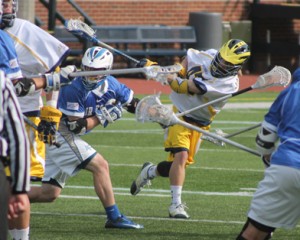The Michigan Wolverines haven’t put together a successful season between the first two attempts at the Division-1 level. U-M started with a club roster in 2012, and added a few key pieces over the offseason. From the eyeball test alone, they improved. According to Tempo-Free Lax, however, they did not. In fact, they got a little worse. Most of that slide came on the offensive side of the ball.
The Overall Numbers
Michigan’s offense in 2012 operated at an efficiency mark of 24.08, good for 54th nationally. The 2013 offense notched a 21.82 number, 62nd nationally. While the slide in the raw numbers (both account for strength of schedule) isn’t that great, given that the national scoring average actually went up slightly, it’s no bueno.
One thing that TFL doesn’t account for (yet, at least – we’ll look into implementing it) is how many of those offensive possessions didn’t even have a chance to score, because they involved a failed clear before getting into the offensive box. Without crunching all the numbers, Michigan actually cleared much better in 2013 than 2012, so the numbers might show an even bigger dropoff with all that taken into account. Why?
The Talent
Who did the scoring for Michigan in 2012? By and large, four players carried the offense: 5th-year seniors Trevor Yealy and Alex Vasileff and juniors Willie Steenland and Thomas Paras. Yealy and Vasileff obviously didn’t return in 2013, Steenland moved to defensive midfield, and Paras was banged up to the point of hardly seeing the field in half the 2013 games.
The scoring burden in 2013 was carried by freshman midfielders Mike Hernandez and Kyle Jackson and a shell-of-himself Paras (Will Meter, like Paras, reprised his role from the previous year in a banged-up state). The raw talent may have been an upgrade, but that talent was raw indeed.
The System
How much of the decrease in offensive production has to do with a system change? The Maize and Blue went from Judd Lattimore pulling the strings to Ryan Danehy. Was there some magic to Lattimore’s scheme? A look at some of the number differences:
- Michigan took 0.49 shots per possession in 2012. That increased to 0.60 in 2013.
- Michigan’s shooting percentage was one of the best in the country in 2012 at 31.36%. That decreased to 20.32% in 2013.
- Michigan assisted on .478 of goals in 2012. That increased to .489 in 2013.
- Michigan turned it over on .554 of possessions in 2012. That decreased to .480 in 2013.
So, Michigan’s possessions ended in very different ways across the two seasons. In 2012, most of them ended in a turnover, often before advancing into the offensive box. In 2013, more of them ended with a shot, albeit one saved by the goalie.
The improvement in assist rate shows a cohesive offensive structure that gets shots. The shooting percentage seems to show that Michigan’s talent either is 1) not good enough to make shots (unlikely), or 2) not experienced enough to know what is a good shot. It comes back to the experience factor again.
From the eyeball test, many of Michigan’s possessions in 2012 ended when the Wolverines tried to cram it inside to the crease attackman (usually Trevor Yealy), and that resulted in either a turnover or a high-percentage shot. That is borne out by the numbers – though the smallish difference in assist rate also shows they had some individual plays as well.
In 2013, many Michigan possessions ended with Mike Hernandez or Kyle Jackson going bombs away from the outside, with a lot of time and room, but also quite a bit of distance to the goal. Again, the numbers bear that out.
The Short Term
Though the offense got quite a bit uglier from 2012 to 2013, breaking down the numbers in a little more depth seems to indicate that youth and injuries – not scheme – was behind most of the slide. Michigan is now less averse to a fastbreak offense (based on the coaching clinics in each of the past two years, the two offensive coordinators couldn’t be more diametrically opposed on that front), and will be able to capitalize off it.
When the talent in Michigan’s system is both extant and experienced, this should round into a strong unit. Some of that experience is now in place. Paras is back for his fifth year and Meter his third (hopefully healthy on both counts), everybody will be entering the second year in the same Division-1 system for the first time ever, and Hernandez and Jackson have a year at this level under their belts. There should also be more talent than last year. Last year’s No. 11 scorer – Steenland, with all of one point on the year – is the top departure, while Michigan adds Under Armour All-Americans Brendan Gaughan (off a redshirt) and Ian King at attack, along with several other highly touted recruits.
The Long Term
There’s also no doubt that Danehy is an upgrade from a team chemistry standpoint and almost certainly from a recruiting standpoint as well. Even if Lattimore’s system was also a great one, the overall fit for Danehy seems to be better.
He will be plugging this year’s talented freshmen into his system very soon. He’s also been instrumental in landing several talented recruits in the 2014 and 2015 classes, but particularly the 2016 group. The current high school sophomores should provide a huge boost, with two Inside Lacrosse top-15 players on offense in midfielder Christian Ford and attack Henry Adams.
The past may be ugly in Ann Arbor, but the future is bright.


I would bet that the new shot clock rules also added to the drop in offensive production between 2012 (lack of varsity experience) versus 2013 (youth, injuries, and lack of varsity experience) for Michigan. Basically, rushed shots (2013) vs higher-percentage shots (2012).